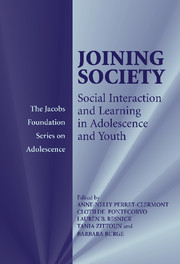Book contents
- Frontmatter
- Contents
- List of Contributors
- Foreword
- Preface
- I Introduction
- II Youth-Constructed Socialization
- III Personal Agency Through Collective Activity
- IV Learning in Practice and Discourse
- V Intergenerational Sites for Thinking
- VI Pathways to Adulthood in National Context
- 19 Joining Society in Europe: Convergence or Sustainability of National Specificities
- 20 The School-to-Work Transition: Problems and Indicators
- 21 To Be Young in Yugoslavia: Life After a Social Chernobyl
- 22 Youth and Unions in North America's Service Society
- 23 Joining Society: With What Certainty?
- Index
- References
20 - The School-to-Work Transition: Problems and Indicators
Published online by Cambridge University Press: 08 January 2010
- Frontmatter
- Contents
- List of Contributors
- Foreword
- Preface
- I Introduction
- II Youth-Constructed Socialization
- III Personal Agency Through Collective Activity
- IV Learning in Practice and Discourse
- V Intergenerational Sites for Thinking
- VI Pathways to Adulthood in National Context
- 19 Joining Society in Europe: Convergence or Sustainability of National Specificities
- 20 The School-to-Work Transition: Problems and Indicators
- 21 To Be Young in Yugoslavia: Life After a Social Chernobyl
- 22 Youth and Unions in North America's Service Society
- 23 Joining Society: With What Certainty?
- Index
- References
Summary
The school-to-work transition is a catchall term for the activities of young people as they bounce around or struggle along between full-time schooling and full-time, possibly career, employment. The activities in question include vocational education, work experience, unemployment, labor market programs, casual work, and fixed-term employment. The transition has become the focus of considerable interest, both academic and policy-oriented.
In some accounts, the school-to-work transition has become longer and more tortuous, at least in advanced economies (Organization for Economic Cooperation and Development [OECD], 1996, 1998). A leading transition attribute, youth status in the labor market, is said to have deteriorated in virtually all OECD countries (Blanchflower & Freeman, 2000). Others emphasize cross-country differences in transition patterns, with German and Japanese institutions performing particularly well (Ryan, 2001).
The accuracy of such generalizations is an empirical issue. Their evaluation would be helped if it were possible to quantify transition attributes comprehensively and consistently. This chapter discusses two sets of measurement problems: those involved, first, in gauging employment-related difficulties and, second, in summarizing national transitions at a particular time in a way that permits comparisons across countries and periods. The evidence concerns teenagers in eight advanced economies, supplemented by historical data for the United Kingdom.
Youth Employment Problems
The first step in measuring the employment problems facing any age group has traditionally been the unemployment rate: the share of the labor force that lacks paid work while showing interest in finding work and being available for work if it is found.
- Type
- Chapter
- Information
- Joining SocietySocial Interaction and Learning in Adolescence and Youth, pp. 286 - 299Publisher: Cambridge University PressPrint publication year: 2003
References
- 3
- Cited by

